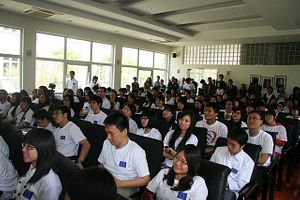In 2015, China announced the “Double World-Class Project,” an initiative to develop world-class universities and first-class disciplines. Since the project was announced, the Chinese education sector has been waiting to find out which universities would benefit from the project via increased financial and other resources.
On September 21, the Chinese authorities — the education ministry, the finance ministry, and the National Development and Reform Commission (NDRC) — finally released the list of universities and colleges that are to be included in the project. A total of 42 universities are qualified to develop into a world-class level. And another 95 institutions — including the 42 universities above — are designated to develop world-class courses.
There are over 2,000 universities and colleges in China. China’s higher education sector is highly unified, centralized and closed. The majority of universities are public institutions and receive funding from the central, as well as the local, governments. Because of this structure, those universities included in the project will immediately gain more funding directly from the government; at the same time, these universities will also be able to recruit the best students who pass the annual national college exam. Inclusion in the project will therefore boost the reputation of the institutions and draw in additional funding as well as attract top talent.
Prior to the “Double World-Class Project,” China had two similar projects: the “211” and “985” projects launched by former President Jiang Zemin in the 1990s. Both projects aimed to strengthen about 100 institutions of higher education and key disciplinary areas in order to promote China’s educational competitiveness in the world. As the chosen institutions received tangible benefits from the projects, the gap between the 211 project universities and common public universities became wider. This had a geographic aspect as well and contributed to the further widening of the existing education gap between different regions. Universities in relatively poor provinces became poorer and degraded academically; while universities in more privileged regions became richer and their academic credentials more robust. In a sense, all the best talent was sucked up by the 211 project universities, many of which were located along China’s east coast. Corruption was also a problem as universities and local governments competed to be included in the project.
Consequently, when the “Double World-Class Project” was announced by the government in 2015 many hoped it would be a more equitable project than its predecessors.
However, the final result seems disappointing. The universities that were included in the previous projects remain included in the new project. The gap between the rich and poor areas also remains prominent: out of the 42 chosen universities, eight are located in Beijing, six in Shanghai, and another few located along the east coas. None of the universities located in the following relatively poor areas — Ningxia, Guizhou, Guangxi, Heilongjiang, Inner Mongolia, Shanxi, Chongqing, Tibet, Qinghai, Hainan, Hebei and Jiangxi — were included in the list.
China’s best known and most privileged institutions — Peking University and Tsinghua University, in particular — are set to continue to receive the most resources as they have the most disciplines included in the list of those targeted to be developed to the world-class level
For example, in 2013 Tsinghua University’s scientific research funding reached 3.9 billion yuan (around $600 million). More than 70 percent of the total was funded by the government. In sharp contrast, Southwest Petroleum University, a common university located in Sichuan, received only 460 million yuan (around $70 million) for scientific research funding. Only 26.1 percent of the total was funded by the government. Southwest Petroleum University ranked first among other common (non-project) universities in terms of scientific research funding.
That being said, the fundamental goal of the “Double World-Class Project” is to elevate the best Chinese universities to the world-class level, so it is designed as a merit-based project assisting the best to become even better. The selection process for the latest project was also much more fair than in the past. The chosen institutions were selected by an independent committee after a process of peer competition, expert review and government evaluation. Lastly, the project introduces a competition mechanism in which under-performing universities could be disqualified from the list, while the well-performing universities could be included in the next round of evaluation.
These improvements, however, can hardly solve the severe educational imbalance in China, a problem that deserves decidedly more attention.
































